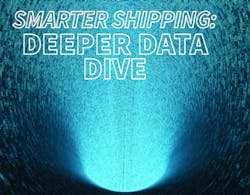What if shipping was more than moving a load from point A to point B, more than a quoted rate or pickup time, more than how quickly can you get it there? What if the wealth of data many fleets and trucking companies are generating and working with could be factored in for more accurate rates and better, more beneficial planning? What if that planning included things like consideration of drivers’ time and their quality of life?
That’s all possible, at least in theory, though it may take some doing. This is a work in progress for fleets: some are building additional data into shipping contracts, yet many aren’t or don’t have visibility of the information required. Consider which side of the coin you’re on now—or would like to be—because companies are innovating, and technology and applications available today or in the pipeline can help carriers, 3PLs and others involved in the distribution business get smarter about shipping.
"It may sound cliché, but it’s work smarter, not harder; I think we have a lot of opportunities to do that in our industry," says Tommy Barnes, president of project44. His company provides a sort of data communication conduit for trucking: project44’s technology is a global application program interface (API) hub that allows shippers, carriers and others in the distribution chain access to info from each other’s systems.
Compartmentalization among those entities is part of the roadblock to more data-rich planning and contracting in trucking, Barnes says. “Start with raw material and pull it out of the ground, then move it all the way to products for consumers, wherever they are,” Barnes says. “If you look at all the interconnected data points, it’s crazy. I’ve spent time on the shipper, 3PL and carrier sides, and I don’t know how we can effectively communicate and manage ourselves.”
For an asset-based carrier, there’s only so much return on invested capital, he points out, so to increase profitability, the name of the game is reduce costs or raise rates. There’s little room for either, Barnes contends, so what those carriers should focus on is getting more out of what they have by maximizing utilization.
By using more data to plan shipments, “you’re solving a problem around drivers and utilization of those drivers by working smarter,” he tells Fleet Owner. “That gets into flexibility of information, and using that information to drive change.”
Though it’s not necessarily a model that scales up to trucking, Barnes gives the example of Uber drivers. “What they’re working with is all APIs and a mobile phone,” he says. “They’re focused on density and utilization of their car in a particular area. They can communicate and adjust in real time and make decisions based on supply and demand.
“In today’s world of trucking, you can’t do those things very well—especially from the truckload carrier, shipper and 3PL sides of it,” he continues.
One of Barnes’ pet peeves in trucking is when there’s talk of capacity problems. “We do have driver challenges, absolutely. But I think about 35% of our trucks on the road now have available capacity,” he contends. “That gets into utilization of various kinds of fleets, empty miles and other things, but there’s a lot of available capacity.” The objective, he adds, is to “tap deeper into what I call that ‘smarter space’ to add more value within your network.”
Not always transparent
One carrier looking to find some Zen in data-enriched shipping is K&L Freight Management based in Addison, IL. Stephany Warwick, vice president of business development at K&L, explains that the company is primarily an expedited carrier handling time-sensitive shipments with everything from cargo vans to straight trucks and tractor-trailers. In terms of smarter shipping, “I think the basics are things like hours of service, driver pay, mileage, and wait times,” she says. “You often see customers having a disconnection with their shippers, shippers having a disconnection with carriers, and carriers having a disconnection with their drivers.”
K&L uses system data to target empty miles, Warwick notes. “That’s a huge factor in the way that we look at our information,” she says, “and another thing is looking at those wait times.” In the Chicago area, she notes that local runs—maybe for a very short distance—can be difficult to gauge. “You’re pricing that sometimes based off of transit, but you don’t know until afterward whether those locations are easy pickups and deliveries,” Warwick points out.
“Unfortunately, when you’re setting up these contracts, you don’t always have that transparency from the customer,” she explains. “You can have all the data and information you want on the carrier end, but if that information isn’t transparent on the customer side, it’s hard to accommodate what makes sense for a yearly bid.”
Even without all the transparency they’d like, carriers can help by using data from their own systems—K&L uses a McLeod technology platform—to price flexibly. “There’s a lot we have on our end that we can look at,” Warwick notes. “It allows us to be smarter with how we price and be a lot more competitive with other carriers as well.”
“Being able to have that flexibility with the customer and having that data is going to allow us to say, ‘Alright, for quarter one, this is really what we’re going to be looking at; for quarter two, this is our price range’ based on seasonality, region, areas and so on,” Warwick explains.
In planning shipments, there’s better data but also an element of common sense, which Warwick says half-jokingly “isn’t common to everyone.” That could come into play in understanding the traffic problems you’ll find in places like Chicago.
“Educating the customer with the data that we have—not only from our system but the knowledge that we have—is essential,” she says. “Can I get a truck there within an hour? Can I make sure that that driver has enough hours to move it? What’s traffic like? What time do the shipper and receiver close?” Warwick adds. A transportation management system can help, she says, as K&L is able to integrate elements like GPS, traffic, hours of service, and other data “and really streamline that information for the customer.”
What else?
In addition to working on things like drivers’ hours of service and better planning to reduce empty miles, there’s a lot more going on in trucking. How about avoiding or preparing for higher altitude along a route?
That’s one of the elements that ALK Technologies has added to its ALK Maps product, which is powered by the company’s PC*Miler routing engine. “Say someone wants you to move their potato chips or popcorn from here to there,” says Bill Maddox, ALK’s vice president of sales for ALK’s Enterprise Solutions Group. “That’s great; you have a straight line.”
Only it might not be a straight line: the carrier realizes that part of the route will take the product over a mountain and 3,500 ft. above sea level, which will cause those popcorn bags to pop. “And maybe that means it’s not 500 mi., it’s an 800-mi. route,” Maddox explains. “So you can build that in.”
|
"We're seeing a lot of this type of activity with some of the real tech-forward carriers . . . it's a changing world, and you're not just going to be able to operate like you did 10 years ago."—Augie Grasis, CEO of online freight exchange site FreightorGator
|
Another example is ice cream, which unless it’s made with certain gelling stabilizers will turn to liquid at a certain altitude. “If you’re running a reefer truck and you know in advance you’ll be transporting ice cream at high altitude, you can freeze the reefer unit colder than it has to be and still take the load through,” he contends. “Some of these things are more abstract, like if I have to charge you more because I have to run my reefer longer.”
ALK has also just launched road service level conditions in its web-based products, “which would let me know if I’m approaching an area where there’s ice on the road,” Maddox notes. “As a fleet owner, and maybe as a negotiator with the shipper, I could try to route around a problem area like that, which would mean extra miles—but there could be extra costs.
“So it’s not only ‘you get a discount’ if we add in more data and information,” he continues. “It might be that this load will cost more.”
Many fleets also employ speed limiters on their trucks as a cost-saving and safety measure, and the Dept. of Transportation has proposed speed limiters for all heavy trucks. That’s a factor in planning, and ALK now allows a speed limit to be added in PC*Miler. And meanwhile, “live” and “real-time” info are becoming more so: in addition to historic and updated traffic information for route planning, ALK’s and other technologies will allow carriers to access live feeds from traffic cameras, for instance.
Costs and profitability
If you’re going to use data to plan and price loads smarter, you need to understand the true costs of the job, according to Jack Jones, vice president for truckload product development and apps for Transportation Costing Group (TCG), an SMC3 company. And he says better cost info could help open up new business possibilities.
“You don’t understand if decisions you’re making are generating a profit until you understand the costs that they’re creating,” Jones notes.
TCG’s technology pulls together data from various carrier accounting, dispatch, legacy systems, and more to create, as he calls it, “actionable intelligence.” One of the exercises TCG’s client carriers go through is to look for loads they might’ve avoided previously—business with a number of high-cost indicators, for example.
“Maybe it’s deadhead miles or lumper services, where you have to hire somebody to help load and unload. Maybe it’s stop-offs for partial unloading,” he says. “These are all considered resources or services that drive costs into moving a load.
“Sometimes those same high-cost indicators end up being high-profit indicators—or at least high-profit opportunities,” Jones continues. Carriers shouldn’t make any assumptions, he cautions: “Just because this is a high-paying load doesn’t mean it’s more profitable; just because it’s a high-cost load does not mean that it’s less profitable.”
Once a carrier understands that information, it can be used to project costs and profitability for loads with similar characteristics, he says.
Any data you want
That’s the same principle you’ll find driving business intelligence offerings today at TMW Systems, freshly branded as the company’s Reveal series of products.
“There’s an endless stream of inputs that you can use to make better business decisions” with Reveal, says Brian Larwig, one of the company’s general managers. “We’re talking about available data, available inputs—more information for decision-makers to better decide if picking up this load, this volume, this account makes sense.”
According to Larwig, just about any business factor a carrier could wish to include in Reveal is “cloud-based, easily consumable and configured,” emphasizing that “that’s not configurable; that’s configured, as in past tense.” The system offers some 150 preconfigured dashboard options that are “purpose-built for the transportation industry,” he says, “and with that, it’s all drag-and-drop tools—I don’t want this content, I do want this data element.
“What we’re doing is getting as many factors that you have coming into this and bring them into play to help you make decisions,” Larwig continues. A large problem carriers have is that the bidding process is “overly complex and disjointed,” he contends, and TMW’s Engage.Bid management tools aim to fix that.
“Let’s say you do 100 bids a month. Out of those 100, there were probably 10 different people on your staff who did them, and they came from 50 different sources in 30 different formats. None of it’s indexable, and none of it’s referenceable,” Larwig says. Taking two different bids, however, 90% of the data entered might be identical—”you just had to go back and look it all up each time.”
“There’s no master data management component to it, and that’s the part we’re bringing in with the Engage series for the bidding process,” he says. The system’s utility builds over time. “With Bid No. 1, you see some advantage, and your 10 analysts all are using the same tool and same format. With bid No. 500, though, now all 499 are referenceable to you.”
Carriers can use the TMW tools to look at their own data historically but can also get a market-wide snapshot. “You can see, on this lane, at what price point, how many loads on average are they picking up to and from—and see how you’re bidding it compared to them,” Larwig notes.
Instant pricing
From the basic to the intricate—and indeed, perhaps even limitless—factors that a carrier can fold into the shipping equation somehow, the most elemental lever to pull is price. On the online freight exchange site FreightorGator, a few intrepid carriers have begun using dynamic pricing capability to up their utilization.
Although the concept of what’s essentially price adjustment on the fly is “pretty nascent,” says FreightorGator CEO and founder Augie Grasis, “some are doing it already.” His company’s site, which removes third parties from freight booking and particularly targets less-complex loads, can help ensure lower rates get through to the potential shipper, he contends.
The idea with dynamic pricing is to fill trucks when you need to. If a carrier is running empty miles along a route, the company could offer an attractive rate to try to pick up some freight on those trucks.
Grasis contends that using more data to tweak shipping is becoming a trend. “We’re seeing a lot of this type of activity with some of the real tech-forward carriers,” he tells Fleet Owner. “And I think that over the next few years, you’re going to see more and more carriers jumping in and investing in understanding their operations better through data.”
And that could be an important differentiator going forward for carriers. “You may see a lot of consolidation over the next five years or so where the ‘haves’—the guys that have implemented data systems that make them much more efficient—are going to grab more market share and potentially could buy out the ‘have nots,’” Grasis speculates. “It’s a changing world, and you’re not just going to be able to operate like you did 10 years ago.”
About the Author
Aaron Marsh
Aaron Marsh is a former senior editor of FleetOwner, who wrote for the publication from 2015 to 2019.


